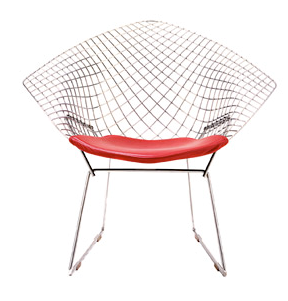Design Classics
Diamond Chair, 1952
Designer: Harry Bertoia
Manufacturer: Knoll

Born in Italy in 1915, Harry (Arieto, in Italian) Bertoia came to America in 1930 to visit his uncle in Detroit. He never left. As luck would have it, one of the local public schools had a program for talented students in the arts and they admitted him. IN 1937, he won a scholarship to study at the Cranbrook Academy of Art in suburban Detroit where he later became a teacher of jewellery design and metal work. While Bertoia is most famous in the design world for his wire mesh chairs, he was primarily a sculptor known for monumental pieces like the “structural screens” he created for the General Motors Technical Centre and the MIT chapel, Bertoia designed jewellery, graphics and, later in life, room-sized and outdoor sculptures, including sound pieces he called Sonambient, which he played like metal harps.
WHAT
Florence and Hans Knoll invited Bertoia to work for their furniture company in 1950 and set him up in a studio near their factory in Pennsylvania. Rather than begin with a design problem, Bertoia preferred to think in terms of “what I would like as a chair.” His method was very sculptural as he worked directly with materials and models rather than drawings. “When I came into rod and wire, whether bent or shaped, I seemed to find myself at home,” he said. The result was the Diamond chair, introduced in 1952. Bertoia developed a series of products using wire mesh, including side chairs in adult and children's sizes, a lounge chair, a bar stool and the recently re-introduced Asymmetric chair. Ironically, although these chairs were meant for mass-production, it turned out to be easier to build them by hand. After the mid-'50s, he returned to his first love, sculpture, and never designed another piece of furniture. But the Diamond chair assures Harry Bertoia's stature as the genius behind one of the icons of 20th-century furniture.
WHY
Bertoia thought of his chairs as art. “If you look at these chairs, you will find they are mostly made of air, just like sculptures,” he said. The light structure, wide form and comfortable way they hold you in their embrace are all delightful. Whether the wire is chrome-plated or painted, they almost disappear into space. Bertoia's wire chairs spawned many imitators, including those ubiquitous vinyl-coated garden chairs. But none has the sculpted grace of their role model.
National Post, March 9, 2006.
